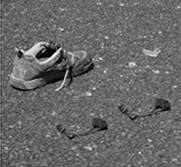Detección de manipulaciones en evidencia digital con fines forenses
Main Article Content
Keywords
Marcado de agua, marcado frágil, multimedia forense, detección de manipulaciones, conjetura de Collatz
Resumen
En términos de evidencia digital, la imagen de la escena de un crimen es un elemento importante en un proceso legal; razón por la cual es indispensable que se garantice su cadena de custodia. Si la imagen es modificada con operaciones como eliminación, duplicidad o difuminado de objetos, debe existir un mecanismo que identifique la existencia de dicha manipulación. En este proyecto, se propone una solución a la cadena de custodia basada en una técnica conocida como marcado de agua. Con el propósito de validar la sensibilidad y efectividad del sistema propuesto, se aplican seis clases de manipulaciones a imágenes marcadas; encontrando una alta sensibilidad a manipulaciones pequeñas (ej. 0.25% del tamaño de la imagen), dado que en todos los casos fue identificada la manipulación. Con la solución propuesta, la autoridad legal puede confiar en la cadena de custodia de la evidencia digital.
Descargas
Referencias
[2] M. Cedillo Hernández, M. Nakano Miyatake, and H. Pérez Meana, “A robustwatermarking technique based on image normalization,”Revista Facultad deIngeniería Universidad de Antioquia, no. 52, pp. 147–160, 2010. 54
[3] L. F. Huallpa Vargas and L. P. Yapu Quispe, “Watermark resistente en eldominio de las frecuencias de imágenes digitales para su autenticación seguramediante autómatas celulares,”Revista Investigación & Desarrollo, vol. 1,no. 11, 2011. 54
[4] D. Renza, D. M. Ballesteros L, and H. D. Ortiz, “Text hiding in imagesbased on qim and ovsf,”IEEE Latin America Transactions, vol. 14, no. 3,pp. 1206–1212, 2016. 54
[5] A. Soria Lorente, R. A. Cumbrera González, and Y. Fonseca Reyna, “Al-goritmo esteganográfico de clave privada en el dominio de la transformadadiscreta del coseno,”Revista Cubana de Ciencias Informáticas, vol. 10, no. 2,pp. 116–131, 2016. 54
[6] X. Qi and X. Xin, “A singular-value-based semi-fragile watermarking schemefor image content authentication with tamper localization,”Journal of VisualCommunication and Image Representation, vol. 30, pp. 312–327, 2015. 55
[7] P. Singh and R. Chadha, “A survey of digital watermarking techniques, ap-plications and attacks,”International Journal of Engineering and InnovativeTechnology (IJEIT), vol. 2, no. 9, pp. 165–175, 2013. 55
[8] N. Boujemaa, E. Yousef, L. Rachid, B. M. Azizet al., “Fragile watermar-king of medical image for content authentication and security,”IJCSN-International Journal of Computer Science and Network, vol. 5, no. 5, 2016.55
[9] M. Botta, D. Cavagnino, and V. Pomponiu, “A successful attack and revisionof a chaotic system based fragile watermarking scheme for image tamperdetection,”AEU-International Journal of Electronics and Communications,vol. 69, no. 1, pp. 242–245, 2015. 55
[10] Y.-C. Fan and Y.-Y. Hsu, “Novel fragile watermarking scheme using an ar-tificial neural network for image authentication,”Applied Mathematics &Information Sciences, vol. 9, no. 5, p. 2681, 2015. 55
[11] S. Dadkhah, A. Abd Manaf, Y. Hori, A. Ella Hassanien, and S. Sadeghi, “Aneffective svd-based image tampering detection and self-recovery using activewatermarking,”Signal Processing: Image Communication, vol. 29, no. 10, pp.1197–1210, 2014. 55
[12] O. Benrhouma, H. Hermassi, and S. Belghith, “Security analysis and im-provement of an active watermarking system for image tampering detectionusing a self-recovery scheme,”Multimedia Tools and Applications, vol. 76,no. 20, pp. 21 133–21 156, 2017. 55
[13] X. Tong, Y. Liu, M. Zhang, and Y. Chen, “A novel chaos-based fragile water-marking for image tampering detection and self-recovery,”Signal Processing:Image Communication, vol. 28, no. 3, pp. 301–308, 2013. 55
[14] A. Joshy and N. Suresh, “A dual security approach for image watermarkingusing aes and dwt,”International Journal of Digital Application & Contem-porary research, vol. 3, no. 1, 2014. 55
[15] D. Renza, D. M. Ballesteros L, and C. Lemus, “Authenticity verificationof audio signals based on fragile watermarking for audio forensics,”ExpertSystems with Applications, vol. 91, pp. 211–222, 2018. 55
[16] D. Renza, C. Lemus, and D. M. Ballesteros L., “Audio authenticity andtampering detection based on information hiding and collatz p-bit code,”Journal of Information Hiding and Multimedia Signal Processing, vol. 8, pp.1294–1304, Nov. 2017. 55
[17] T. Tarver, “The collatz conjecture: Determining an infinite convergent se-quence,”Asian Journal of Mathematical Sciences (AJMS), vol. 1, no. 02, pp.102–104, 2017. 58
[18] V. Gupta and A. Barve, “A review on image watermarking and its techni-ques,”International Journal of Advanced Research in Computer Science andSoftware Engineering, vol. 4, no. 1, pp. 92–97, 2014. 63
[19] S. M. Mousavi, A. Naghsh, and S. Abu-Bakar, “Watermarking techniquesused in medical images: a survey,”Journal of digital imaging, vol. 27, no. 6,pp. 714–729, 2014. 63
[20] P. EDITOR, “Photoshop online en español (en linea),” 2017,http://photoshopen.blogspot.com/. 63
[21] A. Abbasi, C. S. Woo, R. W. Ibrahim, and S. Islam, “Invariant domain wa-termarking using heaviside function of order alpha and fractional gaussianfield,”PloS one, vol. 10, no. 4, p. e0123427, 2015. 66
[22] J. Zhou, W. Sun, L. Dong, X. Liu, O. C. Au, and Y. Y. Tang, “Securereversible image data hiding over encrypted domain via key modulation,”IEEE Transactions on Circuits and Systems for Video Technology, vol. 26,no. 3, pp. 441–452, 2016 67

